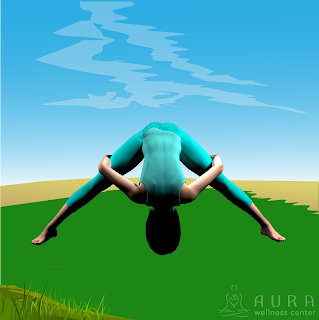Have you noticed that the feet we want in Mountain Pose are the ones we want for much of the practice? Do you remind your students of this? My students might be starting to get just a little bit tired of me talking about Mountain Pose (Tadasana) feet. I believe that the stability of many poses, and all standing poses, begins at their base in the feet. The stability of a house begins in its foundation, of a tree in its roots. Let's first look at what these Mountain Pose feet fundamentals are.
Have feet parallel and hip-distance apart, and heels slightly apart and toes together. Ground down through big toes, yet feel a lift through the insteps. With those actions is also a natural grounding down through the outer edges of the feet. Simply by the way muscles fire together, that creates a natural spiraling of the thighs. The tailbone is heavy; if an arrow were hanging from it, it’d be pointed straight down at one’s mat/floor below. Let’s now look at how these feet are ideally present in a few particular poses.
Warrior II Pose (Virabhadrasana II)
There are many complexities to this pose, at its base those essential Mountain Pose fundamentals. Though the angle of the back foot is different, it is still important to ground down through big toes and lift up through insteps. The result will be a spiraling of the thighs that helps keep joints safely aligned and the pose stable. The angles that will result from these actions in the feet, combined with the shape of the pose, can bring a deep stretch through many muscles in the legs (particularly in the calves and ankles).
That’s just one more reason to fully warm up before practicing such poses, as well as to take things slowly and mindfully, and modify if necessary (such as making a shorter stance or placing soft yet supportive props, such as blanket or wedge, under one or both feet). A grounded Warrior Pose can bring feelings of strength, stability, and empowerment - as well as being great for the body in many ways.
Wide-Legged Forward Fold (Prasarita Padottanasana)
This pose calls for a slight pigeon-toeing-in, so in terms of relationships of body parts, it's similar to a Warrior II foot. That same pushing down through the big toes, lifting of the insteps and pushing down through the back edge, is important here for ensuring that the knees to not collapse in. That allows for stability of the pose, as well as avoiding any strain on the involved joints.
What's also key here, as in every forward fold, is is to keep a gentle bend in the knees and to slightly engage the abdominals. That allows for one's weight to mainly stay on the balls of the feet, therein avoiding straining hamstrings or other involved parts. That established, students can enjoy all the benefits of forward folding as well as a mild inversion. They can breathe deeply and soften any tension they may notice in the face, teeth, jaw, or shoulders.
Gate Pose (Parighasana)
This pose has a Warrior II foot in the extended foot, not in the one behind the bent knee onto which one is kneeling. On the other hand, that foot is ideally parallel rather than at an angle from heel to toes, because of the straight forward facing of the hips in relation to the legs - versus in Warrior II, where the front leg is facing at a different angle from the hips. Much of the stability of the pose, apart from an engaged core and a heavy tailbone, is in that stable Warrior II foot to the side, with Mountain Pose fundamentals (as described).
From that stability, a wonderful side-body, abdominal, and chest stretch is available. Remember that length through the side body is more important than depth of side bend; encourage students to not bend as deeply if the under-side of the spine is curved. As just another basic reminder for this pose, if there’s any sensitivity in the grounded knee, a folded blanket or a rolled mat under it can help.
© Copyright – Aura Wellness Center – Publications Division
Please feel free to share our posts with your friends, colleagues, and favorite social media networks.





No comments:
Post a Comment